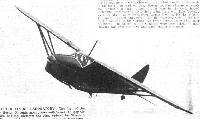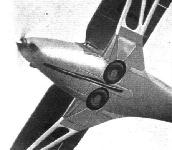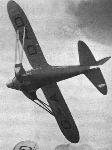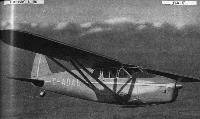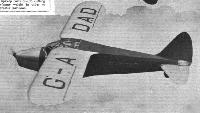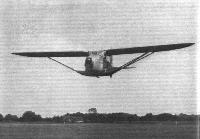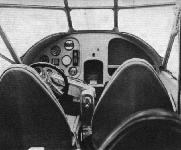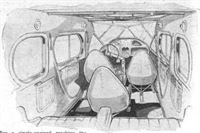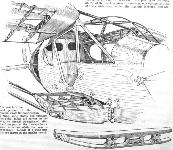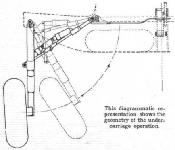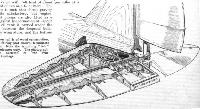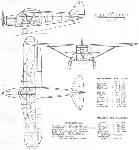
Самолеты Heston
Компания "Heston Aircraft Company" образована в 1934 году на основе "Comper Aircraft Company". Первым изделием новой фирмы стал пятиместный подкосный высокоплан Heston Phoenix I с мотором de Havilland Gipsy Six Series I мощностью 200 л. с. Прототип G-AEAD выполнил первый полет 18 августа 1935 года. Было построено еще два самолета Phoenix I, затем - три доработанных машины варианта Phoenix II с моторами Gipsy VI Series II мощностью 205 л. с. Эти три самолета Phoenix II великолепно показали себя в годы Второй мировой войны в британских ВВС.
<...>
ТАКТИКО-ТЕХНИЧЕСКИЕ ХАРАКТЕРИСТИКИ
Heston Phoenix II
Тип: туристский моноплан
Силовая установка: один 6-цилиндровый рядный ПД de Havilland Gipsy VI Series II мощностью 205 л. с. (153 кВт)
Летные характеристики: максимальная скорость 241 км/ч; крейсерская скорость 217 км/ч; практический потолок 6095 м; дальность 805 км
Масса: пустого 975 кг; максимальная взлетная 1497 кг
Размеры: размах крыла 12,29 м; длина 9,19 м; высота 2,62 м; площадь крыла 24,15 м2
Описание:
- Самолеты Heston
- Flight, October 1935
THE HESTON PHOENIX - Flight, April 1936
MODERN LIGHT AIRCRAFT REVIEWED - Flight, March 1938
British light aircraft - Flight, October 1938
British Commercial Aircraft
Фотографии
-
Jane's All the World Aircraft 1938 / 03 - All the world's aeroplanes
Регистрационный номер: G-AEHJ [6] The Heston "Phoenix" Five-seat Cabin Monoplane (200 h.p. D.H. "Gipsy-Six engine).
-
Flight 1937-01 / Flight Advertisements
Регистрационный номер: G-AEHJ [6] -
Air-Britain Archive 1980-02
Регистрационный номер: G-AEHJ [6] This superb air-to-air shot of Heston Phoenix G-AEHJ shows off the type's advanced aerodynamic features well. G-AEHJ was damaged beyond repair in 1939.
-
Flight 1937-04 / Flight
ANOTHER FLYING LABORATORY: The first of the new Heston Phoenix monoplanes with Series II Gipsy Six engine and v.p. airscrew has been ordered by Standard Radio and will be used for experimental and demonstration work.
-
Flight 1935-09 / Flight
Регистрационный номер: G-ADAD [9] -
Flight 1936-11 / Flight
Регистрационный номер: G-ADAD [9] Although showing unusual economy the Heston Phoenix (D.H. Gipsy Six) has an excellent all-round performance.
-
Flight 1935-11 / Flight
Регистрационный номер: G-ADAD [9] ECONOMICAL COMFORT: A new impression by a Flight photographer of the Heston Phoenix, which carries four passengers, a pilot and luggage at a cruising speed of 125 m.p.h. on 200 h.p.
-
Flight 1936-02 / Flight Advertisements
Регистрационный номер: G-ADAD [9] -
Flight 1936-05 / Flight Advertisements
Регистрационный номер: VH-AJM [2] -
Flight 1935-12 / Flight
The modern trend in cabin types is illustrated in this type, the Heston Phoenix
-
Flight 1936-01 / Flight
OUTSTANDING CIVIL TYPE: One of four machines which made their first appearance during 1935: (2) the Heston Phoenix five-seater with 200 h.p. Gipsy Six;
-
Flight 1935-10 / Flight
Регистрационный номер: G-ADAD [9] -
Flight 1935-09 / Flight
Регистрационный номер: G-ADAD [9] -
Flight 1937-11 / Flight
Регистрационный номер: G-AESV [3] The v.p. airscrew version of the five-seater Heston Phoenix which is one of the quietest single-engined machines on the market.
-
Мировая Авиация 157
Регистрационный номер: G-AEHJ [6] Этот G-AEHJ - последний из трех монопланов Heston Type I Phoenix с моторами de Havilland Gipsy VI Series I. Его убирающееся шасси было очень необычно.
-
Flight 1935-09 / Flight
LOW DRAG: Here ts the first British strutted monoplane to have a retractable undercarriage. The machine is the Heston Aircraft Company s Phoenix, and the feature, with the careful cowling of the Gipsy Six engine, gives a very "clean" appearance.
-
Air Enthusiast 2006-09 / A.Ord-Hume - Folland's Civil Side /Paper planes/
Регистрационный номер: G-ADAD [9] The prototype Heston Phoenix, G-ADAD, first flown in August 1935. Only six of this five-seater with retractable undercarriage were built.
-
Air Enthusiast 2007-09 / A.Ord-Hume - Catalogue of Failure /Paper planes - projects/
Регистрационный номер: G-AEMT Heston's Phoenix cabin monoplane of 1935 used a similar retraction layout to the Naiad and Tribian.
-
Flight 1938-09 / Flight
Регистрационный номер: G-AESV [3] The Heston Phoenix used by Standard Radio has a D.H. controllable pitch airscrew. The small size of the streamlined loop enclosure is noteworthy.
-
Flight 1935-10 / Flight
Регистрационный номер: G-ADAD [9] A side view of the Phoenix. The Titanine finish is pale green, picked out in darker green, and silver.
-
Flight 1937-03 / Flight
Регистрационный номер: G-AEHJ [6] The latest Phoenix, which carries five people on 200 h.p. and has one of the quietest cabins of any single-engined machine.
-
Flight 1936-07 / Flight
Регистрационный номер: G-AEHJ [6] The Heston Phoenix with Gipsy Six engine is the centre of attraction.
-
Flight 1937-01 / Flight
Eminently suitable for charter operation is the Heston Phoenix with a D.H. Gipsy Six engine.
-
Flight 1935-10 / Flight
In spite of its wide fuselage, the Phoenix is very "clean." This photograph also gives a good idea of the pilot's view.
-
Flight 1936-05 / Flight
The Heston Phoenix (Gipsy Six);
-
Jane's All the World Aircraft 1980 / Encyclopedia of Aviation - Aircraft A-Z - v4
Регистрационный номер: G-AESV [3] Heston Phoenix Series II.
-
Flight 1936-03 / Flight
Регистрационный номер: VH-AJM [2] A PHOENIX FOR AUSTRALIA: Mr. C. J. Melrose with the Heston Phoenix which he is shortly flying out to Australia in easy stages. This machine is the first of the production batch and incorporates certain improvements, mainly an even better view than before from the pilot's seat and a somewhat neater Dowty retractable undercarriage. Mr. Melrose hopes to carry a few expense-sharing passengers.
-
Flight 1936-04 / Flight
HOMEWARD BOUND: C. J. Melrose, with his Heston Phoenix (Gipsy Six) photographed shortly before leaving for Australia. He had an official send-off from Heston last Saturday, Mr. C. F. G. McCann, Agent General for South Australia, and Mr. Pemberton-Billing (who is Mr. Melrose's uncle), being among the well-wishers. The fact that an extremely adverse weather report thereupon caused a postponement came as rather an anti-climax. Actually, Mr. Melrose left on Monday. He is proceeding Australiawards in easy stages, and on arrival will use the Phoenix for charter work; he will also represent the makers, the Heston Aircraft.Co. Ltd.
-
Flight 1938-03 / Flight
The high-pressure, flexible oil-pipe from pump to v.p. airscrew operating mechanism can be seen on the Series II Gipsy-Six installed in the Heston Phoenix.
-
Flight 1936-12 / Flight
KEEPING ITS END UP: A small parachute is sometimes carried in the tail of a machine as a precautionary measure during spinning tests. This view shows such an installation on a Heston Phoenix.
-
Flight 1935-10 / Flight
The photograph shows the skeleton of the rear monocoque fuselage.
-
Flight 1936-01 / Flight Advertisements
Регистрационный номер: G-ADAD [9] Heston "Phoenix" (D.H.V.) 200 h.p. Engine) Standard Equipment "Husun" Aperiodic Compass and Smith Aircraft Instruments
-
Flight 1935-10 / Flight
In the cabin: The instruments are grouped in front of the port seat. On the right is a large locker for maps. Note the "swing-over" control.
-
Flight 1936-04 / Flight
Two doors are provided in the Heston Phoenix and the seating arrangements can be modified according to the use to which the machine is to be put. The luggage compartment at the rear has a separate door and, though both are not shown in the diagram, there are two doors for the cabin.
-
Flight 1937-03 / Flight
Easy ingress and egress and an excellent view for the passengers are features of the Heston Phoenix.
-
Flight 1938-03 / Flight
For a single-engined machine the amount of space available in the Heston Phoenix is noteworthy. The seating arrangement shown is that for charter or feeder-line work.
-
Flight 1938-09 / Flight
The dashboard of the Phoenix carries, on the left, normal blind-flying instruments as well as homing and blind-approach indicators, while on the right is the built-in D/F receiver. Below the latter and out of sight behind the right-hand wheel is the control gate for the short-wave fighter set.
-
Flight 1938-09 / Flight
The loop-setting control and its beating dial as they appear in the roof of the Phoenix. The outer ring of the dial is separately rotatable and can be moved to set the machine’s compass bearing so that, from the moving cursor, the magnetic bearing of any particular station may be directly read off. In the centre of the dial there is a quadrantal error curve, so that the amount of this error can be seen for any particular bearing shown by the cursor.
-
Flight 1938-09 / Flight
Some of the special equipment which may be carried against the rear bulkhead of the Phoenix. On the left is the normal medium-wave transmitter and receiver, while on the right is the radio compass receiver with its two indicator units. Its place is normally taken by the ultra-short-wave blind-approach receiver. Just at present an improved version of the compass is being developed.
-
Flight 1939-05 / Flight
The flying scale model - Heston Phoenix.
-
Flight 1935-10 / Flight
This sketch of the front portion of the Phoenix shows the construction of wing, wing stump and fuselage. The petrol tanks are carried in the wing on special strengthened ribs. The front part of the fuselage has a girder structure while the rear is monocoque. Details of a wing-stub spar are shown in the smaller sketch.
-
Flight 1935-10 / Flight
Details of the Dowty retractable undercarriage of the Phoenix. The bottom of the oil tank projects and acts as a cooler.
-
Flight 1935-10 / Flight
This diagrammatic representation shows the geometry of the undercarriage operation.
-
Flight 1935-10 / Flight
The cantilever tail is of wood construction, and a metal fairing (not shown) terminates the fuselage. Note the trimming "tab" on the port elevator only.
- Фотографии




